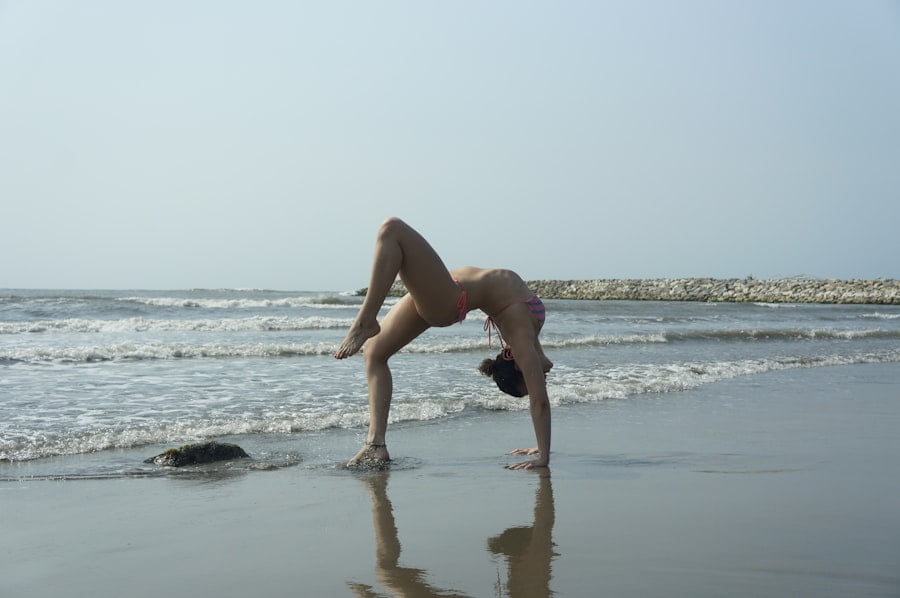
Limber Up: Effective Hamstring Stretches for Enhanced Flexibility and Injury Prevention
Hamstring stretches are an essential component of any fitness routine, as they not only improve flexibility but also help prevent injuries. The hamstrings are a group of muscles located at the back of the thigh, and when they are tight or inflexible, they can lead to lower back pain and other injuries. By incorporating hamstring stretches into your fitness routine, you can increase your range of motion, improve posture, and reduce the risk of muscle strains and tears.
Tight hamstrings can be a common issue for many individuals, especially those who sit for long periods or engage in activities that require repetitive movements. When the hamstrings are tight, they can pull on the pelvis, causing it to tilt and leading to lower back pain. Additionally, tight hamstrings can increase the risk of muscle strains and tears during physical activity. By regularly stretching the hamstrings, you can improve their flexibility and reduce the likelihood of these issues occurring.
Key Takeaways
- Hamstring stretches are important for both flexibility and injury prevention.
- Warm-up exercises can help prepare your hamstrings for stretches.
- Standing, seated, supine, dynamic, partner-assisted, and yoga-inspired stretches can all target your hamstrings.
- Foam rolling can also be used to stretch your hamstrings.
- Incorporating hamstring stretches into your fitness routine can enhance flexibility and prevent injuries.
Warm-Up Exercises: Preparing Your Hamstrings for Stretches
Before diving into hamstring stretches, it is important to warm up the muscles to prepare them for stretching. Warming up helps increase blood flow to the muscles, making them more pliable and less prone to injury. Some examples of warm-up exercises that can be done before hamstring stretches include jogging in place, jumping jacks, and leg swings.
Jogging in place is a simple yet effective warm-up exercise that gets your heart rate up and increases blood flow to your muscles. Start by standing with your feet hip-width apart and begin jogging in place, lifting your knees as high as comfortable. Continue jogging for 1-2 minutes to warm up your entire body.
Jumping jacks are another great warm-up exercise that targets multiple muscle groups, including the hamstrings. Start by standing with your feet together and arms by your sides. Jump your feet out to the sides while simultaneously raising your arms overhead. Jump your feet back together and lower your arms back to your sides. Repeat this motion for 1-2 minutes to warm up your entire body.
Leg swings are a dynamic warm-up exercise that specifically targets the hamstrings. Stand next to a wall or sturdy object for support. Swing one leg forward and backward, keeping it straight and engaging the hamstring muscles. Repeat this motion for 10-15 swings on each leg to warm up the hamstrings.
Standing Hamstring Stretches: Targeting Your Hamstrings While Standing
Standing hamstring stretches are a great way to target the hamstrings while also improving posture and balance. To perform a standing hamstring stretch, follow these steps:
1. Stand tall with your feet hip-width apart.
2. Take a step forward with your right foot, keeping both feet pointing forward.
3. Shift your weight onto your right foot and lift your left foot off the ground.
4. Extend your left leg straight in front of you, keeping it as straight as possible.
5. Hinge forward at the hips, reaching towards your toes with both hands.
6. Hold this position for 20-30 seconds, feeling a stretch in the back of your left leg.
7. Repeat on the other side, stepping forward with your left foot and stretching your right leg.
Standing hamstring stretches can be done anywhere and are particularly beneficial for individuals who spend a lot of time sitting or have tight hamstrings due to their daily activities. By incorporating these stretches into your routine, you can improve flexibility, reduce muscle tension, and promote better posture.
Seated Hamstring Stretches: Stretching Your Hamstrings While Seated
| Seated Hamstring Stretches | Metric |
|---|---|
| Benefits | Improves flexibility, reduces risk of injury, relieves lower back pain |
| How to do it | Sit on the floor with legs extended, reach forward and grab toes or ankles, hold for 30 seconds |
| Frequency | 2-3 times per week |
| Duration | Hold stretch for 30 seconds, repeat 3-4 times |
| Precautions | Avoid if you have a hamstring injury or sciatica, stop if you feel pain |
Seated hamstring stretches are an excellent option for individuals who may have difficulty standing or prefer a seated position for stretching. These stretches can be done on the floor or in a chair and provide similar benefits to standing hamstring stretches. To perform a seated hamstring stretch, follow these steps:
1. Sit on the floor with your legs extended in front of you or sit on the edge of a chair with your feet flat on the ground.
2. Extend your right leg straight in front of you, keeping it as straight as possible.
3. Flex your right foot, pointing your toes towards the ceiling.
4. Hinge forward at the hips, reaching towards your right foot with both hands.
5. Hold this position for 20-30 seconds, feeling a stretch in the back of your right leg.
6. Repeat on the other side, stretching your left leg.
Seated hamstring stretches are particularly beneficial for individuals who may have limited mobility or find it challenging to perform standing stretches. These stretches can be modified to accommodate different fitness levels and can be easily incorporated into a daily stretching routine.
Supine Hamstring Stretches: Lying Down Stretches for Your Hamstrings
Supine hamstring stretches are performed while lying down and provide a deep stretch for the hamstrings. These stretches can be done on a mat or even on a bed, making them accessible to individuals of all fitness levels. To perform a supine hamstring stretch, follow these steps:
1. Lie on your back with your legs extended in front of you.
2. Lift your right leg off the ground and bring it towards your chest, keeping it as straight as possible.
3. Interlace your fingers behind your thigh or calf, gently pulling your leg towards you.
4. Hold this position for 20-30 seconds, feeling a stretch in the back of your right leg.
5. Repeat on the other side, lifting your left leg and bringing it towards your chest.
Supine hamstring stretches are excellent for improving range of motion and reducing muscle soreness. These stretches can be done before or after physical activity to warm up or cool down the muscles, respectively.
Dynamic Hamstring Stretches: Moving Your Hamstrings Through a Range of Motion

Dynamic hamstring stretches involve moving the hamstrings through a range of motion, which helps improve flexibility and prepare the muscles for physical activity. These stretches are particularly beneficial for athletes and individuals who engage in activities that require explosive movements. Some examples of dynamic hamstring stretches include walking lunges and high knees.
Walking lunges are a dynamic stretch that targets the hamstrings, quadriceps, and glutes. Start by standing tall with your feet hip-width apart. Take a step forward with your right foot and lower your body into a lunge position, keeping your right knee directly above your ankle. Push off with your right foot and bring your left foot forward into the next lunge. Continue alternating legs and walking forward for 10-15 lunges.
High knees are another dynamic stretch that targets the hamstrings, quadriceps, and hip flexors. Start by standing tall with your feet hip-width apart. Lift your right knee towards your chest while simultaneously raising your left arm. Lower your right leg back to the ground and repeat on the other side, lifting your left knee towards your chest while raising your right arm. Continue alternating legs and arms for 1-2 minutes.
Dynamic hamstring stretches are an excellent way to warm up the muscles before physical activity and can help improve athletic performance while reducing the risk of injury. These stretches should be done in a controlled manner and should not cause any pain or discomfort.
Partner-Assisted Hamstring Stretches: Stretching Your Hamstrings with a Partner
Partner-assisted hamstring stretches can provide deeper stretches and help improve flexibility by utilizing the assistance of a partner. These stretches can be done with a friend or a trainer and are particularly beneficial for individuals who may have difficulty reaching certain positions on their own. Some examples of partner-assisted hamstring stretches include the seated forward fold with a partner and the standing hamstring stretch with a partner.
The seated forward fold with a partner is a stretch that targets the hamstrings, lower back, and shoulders. Start by sitting on the floor with your legs extended in front of you. Have your partner sit behind you, facing your back. Extend your arms overhead and have your partner gently pull your arms forward, guiding you into a forward fold. Hold this position for 20-30 seconds, feeling a stretch in the back of your legs and lower back.
The standing hamstring stretch with a partner is a stretch that targets the hamstrings and calves. Start by standing tall with your feet hip-width apart. Face your partner and extend one leg straight in front of you, resting it on your partner’s shoulder. Your partner can then gently push against your leg, providing resistance and deepening the stretch. Hold this position for 20-30 seconds and repeat on the other side.
Partner-assisted hamstring stretches can provide deeper stretches and help improve flexibility by utilizing the assistance of a partner. These stretches should be done with caution and communication between both individuals to ensure safety and comfort.
Yoga-Inspired Hamstring Stretches: Incorporating Yoga Poses for Hamstring Flexibility
Yoga-inspired hamstring stretches can be an excellent addition to any fitness routine, as they not only target the hamstrings but also promote relaxation and reduce stress. Yoga poses that target the hamstrings include downward-facing dog, seated forward fold, and standing forward bend.
Downward-facing dog is a yoga pose that targets the hamstrings, calves, and shoulders. Start on your hands and knees, with your hands shoulder-width apart and your knees hip-width apart. Lift your hips towards the ceiling, straightening your legs as much as possible. Press your heels towards the ground while simultaneously pushing your chest towards your thighs. Hold this position for 20-30 seconds, feeling a stretch in the back of your legs and shoulders.
Seated forward fold is a yoga pose that targets the hamstrings, lower back, and shoulders. Start by sitting on the floor with your legs extended in front of you. Inhale and reach your arms overhead, lengthening your spine. Exhale and hinge forward at the hips, reaching towards your toes with both hands. Hold this position for 20-30 seconds, feeling a stretch in the back of your legs and lower back.
Standing forward bend is a yoga pose that targets the hamstrings, calves, and lower back. Start by standing tall with your feet hip-width apart. Inhale and reach your arms overhead, lengthening your spine. Exhale and hinge forward at the hips, reaching towards your toes with both hands. Allow your head and neck to relax. Hold this position for 20-30 seconds, feeling a stretch in the back of your legs and lower back.
Incorporating yoga-inspired hamstring stretches into your fitness routine can provide numerous benefits, including improved flexibility, reduced stress, and increased mindfulness. These stretches can be done at any time of day and can be modified to accommodate different fitness levels.
Foam Rolling for Hamstring Flexibility: Using a Foam Roller to Stretch Your Hamstrings
Foam rolling is a self-myofascial release technique that can be used to stretch and massage the muscles, including the hamstrings. Using a foam roller can help improve range of motion, reduce muscle soreness, and increase blood flow to the muscles. To use a foam roller to stretch your hamstrings, follow these steps:
1. Sit on the floor with a foam roller placed under your right hamstring.
2. Place your hands behind you for support.
3. Lift your hips off the ground and roll back and forth along the length of your hamstring.
4. If you find a tight or tender spot, pause and apply gentle pressure for 20-30 seconds.
5. Continue rolling for 1-2 minutes, then switch to the other leg.
Foam rolling for hamstring flexibility can be done before or after physical activity to warm up or cool down the muscles, respectively. It is important to listen to your body and adjust the pressure and intensity of the foam rolling as needed.
Incorporating Hamstring Stretches into Your Fitness Routine for Enhanced Flexibility and Injury Prevention
Incorporating hamstring stretches into your fitness routine is crucial for enhancing flexibility and preventing injuries. Tight hamstrings can lead to lower back pain and increase the risk of muscle strains and tears. By regularly stretching the hamstrings, you can improve their flexibility, reduce muscle tension, and promote better posture.
There are various types of hamstring stretches that can be incorporated into your fitness routine, including standing stretches, seated stretches, supine stretches, dynamic stretches, partner-assisted stretches, yoga-inspired stretches, and foam rolling. Each type of stretch offers unique benefits and can be modified to accommodate different fitness levels.
By warming up before stretching, utilizing proper form and technique, and listening to your body’s cues, you can safely and effectively stretch your hamstrings. It is important to remember that flexibility takes time to develop, so be patient and consistent with your stretching routine.
In conclusion, hamstring stretches are an essential component of any fitness routine. By incorporating these stretches into your routine, you can improve flexibility, reduce the risk of injury, and enhance overall athletic performance. So don’t forget to give your hamstrings some love and make stretching a regular part of your fitness routine.
FAQs
What are hamstrings?
Hamstrings are a group of three muscles located at the back of the thigh that help in bending the knee and extending the hip.
Why is hamstring flexibility important?
Hamstring flexibility is important for preventing injuries, improving athletic performance, and maintaining good posture.
What are some common hamstring injuries?
Common hamstring injuries include strains, tears, and tendinitis.
How can hamstring stretches prevent injuries?
Hamstring stretches can prevent injuries by increasing flexibility and range of motion, improving blood flow to the muscles, and reducing muscle tension.
What are some effective hamstring stretches?
Effective hamstring stretches include the standing hamstring stretch, seated hamstring stretch, and lying hamstring stretch.
How often should I stretch my hamstrings?
It is recommended to stretch your hamstrings at least 2-3 times per week, or more frequently if you are an athlete or have tight hamstrings.
What are some tips for safe hamstring stretching?
Some tips for safe hamstring stretching include warming up before stretching, avoiding bouncing or jerking movements, and holding each stretch for at least 30 seconds.


















